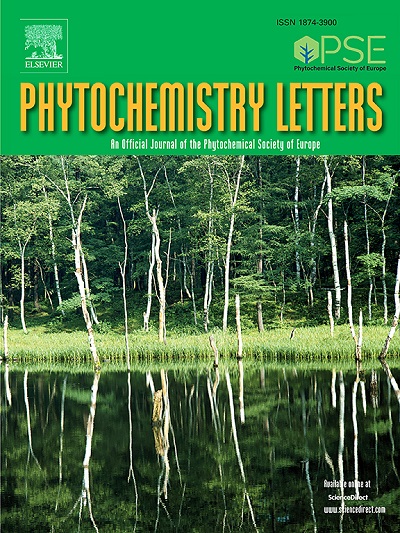白菖蒲油的化学成分及抑菌活性:挥发油和脂肪酸组分的详细分析
IF 1.3
4区 生物学
Q4 CHEMISTRY, MEDICINAL
引用次数: 0
摘要
本研究的目的是确定白菖蒲油挥发油和脂肪酸组分的化学成分。GC-MS/SPME分析结果表明,沙豆油含有多种挥发性化合物,其中萜烯类化合物占比显著(22.3% %)。气相色谱-质谱分析证实,白桦油中含有环戊基脂肪酸,约占脂肪酸组分的80% %。此外,还采用甲醇提取了沙豆油。甲醇提取物进行气相色谱-质谱分析,鉴定脂肪化合物和挥发性化合物。甲醇是环戊烯脂肪酸组分的有效萃取剂。甲醇提取物中环戊基脂肪酸的定量含量与全油中环戊基脂肪酸的含量基本一致。这证明了在本工作中使用的衍生化方法是合适的。研究的另一个关键方面是评估整个油及其甲醇提取物对大肠杆菌、金黄色葡萄球菌和枯草芽孢杆菌等参考菌株的抗菌活性。结果表明,甲醇萃取得到的油及其馏分对上述菌株均有轻微的抑菌作用。本文章由计算机程序翻译,如有差异,请以英文原文为准。
Chemical composition and antibacterial activity of chaulmoogra oil from Hydnocarpus wightiana: A detailed analysis of volatile and fatty acid fractions
The aim of the study was to ascertain the chemical composition of the volatile and fatty acid fractions of chaulmoogra oil from Hydnocarpus wightiana. A series of GC-MS/SPME analyses revealed that chaulmoogra oil contains a diverse array of volatile compounds, with a notable proportion comprising terpene compounds (22.3 %). The GC-MS analysis confirmed the presence of cyclopentenyl fatty acids in chaulmoogra oil from Hydnocarpus wightiana which constituted about 80 % of the fatty acid fraction. Furthermore, the chaulmoogra oil was extracted using methanol. The methanol extract obtained was subjected to GC-MS analysis for the identification of fatty compounds and volatile compounds. Methanol was identified as an effective extractant for the cyclopentenyl fatty acid fraction. The quantitative content of cyclopentenyl fatty acids in the methanol extract was similar to the content of these acids in the whole chaulmoogra oil. This proves that the derivatization method used in this work was appropriate. A further crucial aspect of the research was the assessment of the antibacterial activity of both the whole oil and its methanol extract against reference bacterial strains such as Escherichia coli, Staphylococcus aureus and Bacillus subtilis. The results indicate that both the oil and its fraction obtained through methanol extraction exert a slight bacteriostatic effect on the aforementioned bacterial strains.
求助全文
通过发布文献求助,成功后即可免费获取论文全文。
去求助
来源期刊

Phytochemistry Letters
生物-生化与分子生物学
CiteScore
3.00
自引率
11.80%
发文量
190
审稿时长
34 days
期刊介绍:
Phytochemistry Letters invites rapid communications on all aspects of natural product research including:
• Structural elucidation of natural products
• Analytical evaluation of herbal medicines
• Clinical efficacy, safety and pharmacovigilance of herbal medicines
• Natural product biosynthesis
• Natural product synthesis and chemical modification
• Natural product metabolism
• Chemical ecology
• Biotechnology
• Bioassay-guided isolation
• Pharmacognosy
• Pharmacology of natural products
• Metabolomics
• Ethnobotany and traditional usage
• Genetics of natural products
Manuscripts that detail the isolation of just one new compound are not substantial enough to be sent out of review and are out of scope. Furthermore, where pharmacology has been performed on one new compound to increase the amount of novel data, the pharmacology must be substantial and/or related to the medicinal use of the producing organism.
 求助内容:
求助内容: 应助结果提醒方式:
应助结果提醒方式:


